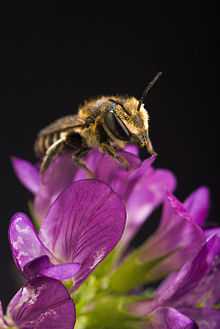Megachile rotundata
| Megachile rotundata | |
|---|---|
 | |
| Scientific classification | |
| Kingdom: | Animalia |
| Phylum: | Arthropoda |
| Class: | Insecta |
| Order: | Hymenoptera |
| Suborder: | Apocrita |
| Superfamily: | Apoidea |
| Family: | Megachilidae |
| Subfamily: | Megachilinae |
| Tribe: | Megachilini |
| Genus: | Megachile |
| Subgenus: | Eutricharaea |
| Species: | M. rotundata |
| Binomial name | |
| Megachile rotundata (Fabricius, 1787) | |
Megachile rotundata, the alfalfa leafcutter bee or lucerne leafcutter bee[1] is a European bee that has been introduced to other regions. As a solitary bee species, it does not build colonies or store honey, but is a very efficient pollinator of alfalfa, carrots and some other vegetables.
In North America, the species was deliberately imported to assist in the pollination of food crops, but has now become feral and widespread.[2] In New Zealand and Australia, it was also introduced to assist in the pollination of alfalfa (known locally as lucerne), in 1971 in New Zealand,[3][4] and 1987 in Australia.[5][6]
Female alfalfa leafcutter bees have stingers, but both sexes will use their mandibles as a defensive mechanism, usually only defending themselves when squeezed or antagonized. Therefore, bee suits, such as those required with honey bees, are not necessary when dealing with these bees. The ratio of males to females is generally two to one.
Females in the wild create nests in small holes in the ground or in available cracks/crevices in trees or buildings. The nests are composed of a string of individual cells, as many as the space will allow. When managed for pollination, the females are induced to nest in drinking straws or drilled blocks of wood.[2]
Each cell is made from circular disks cut from plant leaves using the bee's mandibles, hence the name "leafcutter". While the bees do not store honey, females do collect pollen and nectar which they store in the cells of their nests. Each cell contains one pollen and nectar ball and one egg.[2] The larva develops rapidly, consuming the pollen ball and entering diapause when the pollen is fully consumed. The next spring, the mature larva pupates and completes its development. Once the bee is developed, it cuts its way out from the nest.
When these bees are supplied to farmers for pollinating crops, they are usually supplied in a dormant state called pre-pupa, which is kept in the dormant state by a constant temperature of about 7°C. At a time that is appropriate for the crop's flowers, the farmer puts the pre-pupal form in an incubating environment, which is a constant temperature of about 27°C. The adult bees emerge from the pupal form after about 25 days at that temperature. Then the farmer brings the bees to the field.[7]
References
- ↑ "Megachile rotundata (Fabricius)". Australian Insect Common Names. CSIRO. 19 September 2004. Retrieved 2009-07-14.
- ↑ 2.0 2.1 2.2 Milius, Susan (January 6, 2007). "Most Bees Live Alone: No hives, no honey, but maybe help for crops". Science News 171 (1): 11–3. doi:10.1002/scin.2007.5591710110.
- ↑ "Introduced Bees in New Zealand", New Zealand Entomologist Vol 33: 92-101 (February 2010)
- ↑ "Selection and importation of new pollinators to New Zealand", B. J. Donovan, DSIR Plant Protection
- ↑ "There have been several importations of the alfalfa leafcutting bee, beginning in 1987...", Australian Honey Industry Monthly Review, January 2001
- ↑ "Introducing the Alfalfa Leafcutting Bee..."
- ↑ "How to Manage Alfalfa Leafcutting Bees", a publication of the University of Maine Agricultural Cooperative Extension, year 2007.